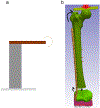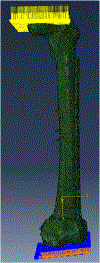An analytical model of lateral condylar plate working length
- PMID: 37871506
- PMCID: PMC10848195
- DOI: 10.1016/j.clinbiomech.2023.106129
An analytical model of lateral condylar plate working length
Abstract
Background: The locking plate is a common device to treat distal femur fractures. Healing is affected by construct stiffness, thus many surgeon-controlled variables such as working length have been examined for their effects on strain at the fracture. No convenient analytical model which aids surgeons in determining working length has yet been described. We propose an analytical model and compare it to finite element analysis and cadaveric biomechanical testing.
Methods: First, an analytical model based on a cantilever beam equation was derived. Next, a finite element model was developed based on a CT scan of a "fresh-frozen" cadaveric femur. Third, biomechanical testing in single-leg stance loading was performed on the cadaver. In all methods, strain at the fracture was recorded. An ANCOVA test was conducted to compare the strains.
Findings: In all models, as the working length increased so did strain. For strain at the fracture, the shortest working length (35 mm) had a strain of 8% in the analytical model, 9% in the finite element model, and 7% for the cadaver. The longest working length (140 mm) demonstrated strain of 15% in the analytical model, and the finite element and biomechanical tests both demonstrated strain of 14%.
Interpretation: The strain predicted by the analytical model was consistent with the strain observed in both the finite element and biomechanical models. As demonstrated in existing literature, increasing the working length increases strain at the fracture site. Additional work is required to refine and establish validity and reliability of the analytical model.
Keywords: Analytical model; Distal femur fracture; Dynamic condylar screw; Finite element analysis; Lateral condylar plate.
Copyright © 2023 Elsevier Ltd. All rights reserved.
Conflict of interest statement
Declaration of Competing Interest None.
Figures







References
-
- Aguirre-Garcia J, Hernandez-Navarro C, Moreno-Bello K, Arizmendi-Morquecho A, Chavez-Valdez A, Aguilera-Camacho D, Garcia-Miranda J, 2014. Hardness and friction performance of poly (methylmethacrylate)/biphasic calcium phosphate coating on steel. In: MRS Online Proceedings Library (OPL), p. 1609.
-
- Chao CK, Chen YL, Wu JM, Lin CH, Chuang TY, Lin J, 2020. Contradictory working length effects in locked plating of the distal and middle femoral fractures-a biomechanical study. Clin. Biomech 80, 105198. - PubMed
-
- Disegi J, 2009. Wrought 18% Chromium-14% Nickel-2.5% Molybdenum Stainless Steel. Depuy Synthes.
Publication types
MeSH terms
Grants and funding
LinkOut - more resources
Full Text Sources
Medical
Research Materials

